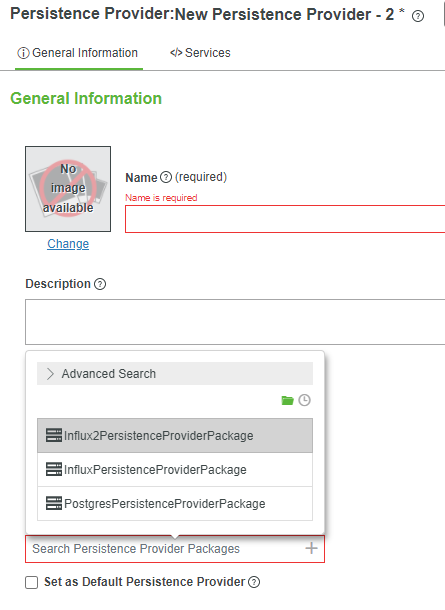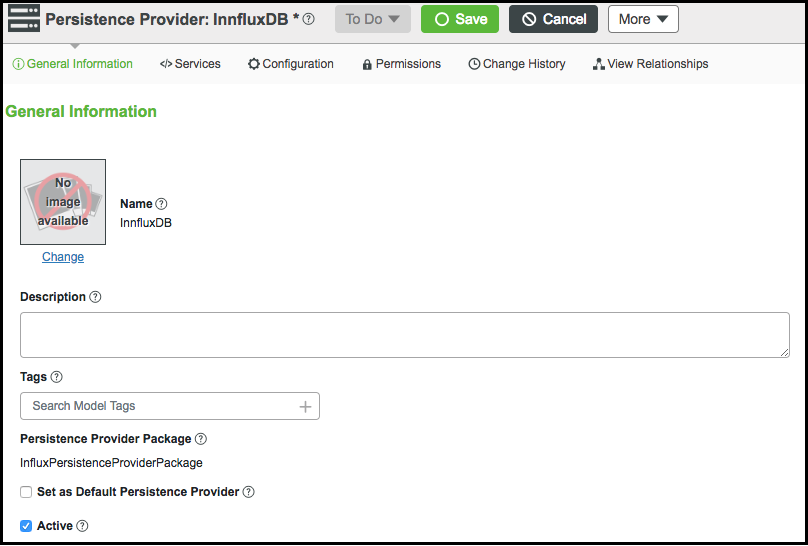Configuring Influx2PersistenceProviderPackage
To configure the Influx2PersistenceProviderPackage, perform the following steps:
1. In ThingWorx Composer, create a new persistence provider.

2. In the Persistence Provider Package field, select Influx2PersistenceProviderPackage.

3. Click Save.
4. Click the Configuration tab and configure the connection information as necessary and save. Reference the configuration options in the tables below. If you are using a persistence provider instance (created using InfluxDB persistence provider package) as the default persistence provider, you can edit the following stream and value stream queue configurations settings. These edits then apply to all streams and value streams. You cannot change these settings for a specific stream or value stream.
When switching the persistence provider of a value stream (for example, from ThingworxPersistenceProvider to InfluxPersistenceProviderPackage), any Thing that implements a value stream must call the RestartThing service to retrieve entries written to the new persistence provider. If the Things are not restarted, entries may be written to the database, but they are not retrieved until the Thing is restarted. |

Name | Description | Default Value | ||
|---|---|---|---|---|
Connection URL | The URL of the database from which you should acquire connections. | http://localhost:8086 | ||
Token | The security token for accessing system, used instead of a password. (like an appkey). | |||
Organization Name | Name of the organization | |||
Bucket Name | Name of the data bucket (schema where all data is stored). | |||
Auto Create Bucket | When set to true, creates the bucket specified in bucketName if it does not already exist. Otherwise an error will occur if bucket does not exist. | False | ||
Retention Period (days) | The number of days data is retained. Data will be deleted after this period. The default 0, which is to retain the data forever. | 0 | ||
Batch Size | This is the batch size used by the influx client. It will always send data points in batches for increased performance. This is in addition to the stream batch size. When batch size number of points are ready to send it sends the data to influx.
| 1000 | ||
Flush Interval | Indicates how often the influx client will flush data if it has not reached its batch size. Value is specified in milliseconds.
| 1000 or once per second | ||
Fetch Size of data from the persistence provider | The count of rows to be fetched in batches instead of caching all rows on client side. | 5000 | ||
Time for Connection Timeout | The amount of time to attempt a connection to influx. Value is specified in seconds. | 10 | ||
Time for Read Timeout | The amount of time to read data from influx for a request. Value is specified in seconds. | 10 | ||
Time for Write Timeout | The amount of time to try to write data to influx. Value is specified in seconds.
| 20 | ||
Log Level | The log level of the influx client and the logs are sent to console output. The values can be NONE, BASIC, HEADERS or BODY with each level providing more information. | NONE |
Name | Description | Base Type | Default Value | ||||
|---|---|---|---|---|---|---|---|
Max Wait Time Before Flushing Stream Buffer (millisec) | Number of milliseconds the system waits before flushing the stream buffer. | Number | 10000 | ||||
Max no. of Items Before Flushing Stream Buffer | Maximum number of items to accumulate before flushing the stream buffer. | Number | 1000 | ||||
Buffer Status Scan Rate (millisec). | The buffer status is checked at the specified rate value in milliseconds. | Number | 5 | ||||
Max Queue Size | Maximum number of stream entries to queue. Once the specified value is reached, the subsequent entries are rejected. | Number | 250000 | ||||
Max no. of Stream Writes in Process Block | Maximum number of stream writes to process in one block. | Number | 2500 | ||||
Number of Processing Threads | Number of processing threads dedicated to the stream.
| Number | 5 | ||||
Max no. of Value Stream Write retry attempts
| The number of times to retry batch writes if there is a write failure.
| Integer | 5 |
Name | Description | Base Type | Default Value | ||||
|---|---|---|---|---|---|---|---|
Max Wait Time Before Flushing Value Stream Buffer (millisec) | Number of milliseconds the system waits before flushing the value stream buffer. | Number | 10000 | ||||
Max no. of Items Before Flushing Value Buffer | Maximum number of items to accumulate before flushing the value stream buffer. | Number | 1000 | ||||
Buffer Status Scan Rate (millisec) | The buffer status is checked at the specified rate value in milliseconds. | Number | 5 | ||||
Max Queue Size | Maximum number of value stream entries to queue. Once the specified value is reached, the following entries are rejected. | Number | 1000000 | ||||
Max no. of Value Stream Writes in Process Block | Maximum number of items to process in one block. | Number | 25000 | ||||
Number of Processing Threads | Number of processing threads allocated to the value stream.
| Number | 10 | ||||
Max no. of Value Stream Write retry attempts
| The number of times to retry batch writes if there is a write failure.
| Integer | 5 |
5. Click the General Information tab and select the Active check box.

6. Click Save.